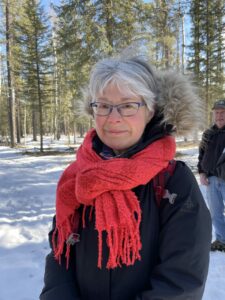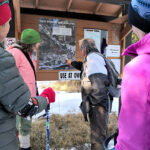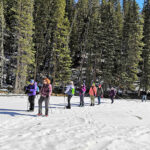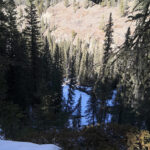Winter Hike on Waiparous Creek
March 15, 2022
 By – Peta Stuart
By – Peta Stuart
It’s your AWA trusty reporter, checking in after a great Alberta Wilderness Association Adventure along Waiparous Creek led by Mr Heinz Unger.
Our drive west toward this area afforded snow-capped Rocky mountain views; of particular note, the curiously-shaped Devil’s Head mountain. We had a sighting of bald eagles (Haliaeetus leucocephalus) and passed the Jumping Pound plant flares tickling the sky.
Our destination, Waiparous Creek, is steeped in history. The First Nations considered this place an important winter hunting ground. According to the book Place Names of Alberta, the name Waiparous is a corruption of the Stoney Indian name meaning “Crow (Indian) scalp” (Karamitsanis 1992). The Simpson and Palliser Expeditions of 1841 and 1858 both mention the confluence of the Waiparous Creek and the Ghost River.
The Eau Claire (there is a Waiparous trail with this moniker) Lumber Company harvested lumber in this area in the 1920’s. Logs were flushed down the Waiparous Creek and Ghost River. Remains of the temporary log dams can be observed along Waiparous Creek.
Our hardy group of hikers donned ice cleats and filed behind Heinz along the (mostly) frozen river. Beautiful sandstone walls line the creek. The river ice sparkled under bluebird skies. On the way to see the confluence of Waiparous Creek and the Ghost River, we identified cougar (Felis concolor) prints in the snow. We also noted a stonefly adult (Plectoptera) wiggling across the snow in search of a mate. These ancient insects have been around for 300 million years.
The Waiparous Creek area is in the montane zone. The forest is mixed conifer – in particular white spruce (Picea glauca) – and a smattering of deciduous trees. We noted at least two kinds of juniper peeping from the snow; the prickly common juniper (Juniperus communis) and the creeping juniper (Juniperus horizontalis).
The moist banks of Waiparous Creek are a perfect home for the evergreen Stairstep moss (Hylocomnium splendens). Each branch along this feather moss main stem represents a year’s growth. We also noted the delicate dwarf scouring rush (Equisetum scirpoides) that grows alongside a natural spring; at first it looked like a patch of grass. We had good discussions comparing the Waiparous natural forest to a large tract of unfortunate Fire Smart forest that stretches far from human habitation.
Thank you to Kris for bringing up the rear! The Unger family treated us to a delightful end-of-adventure with mulled cider and sweets, overlooking a panorama of the Waiparous to the Rockies, and cohosted by a pair of ravens (Corvus corax). Keep this natural area safe!
Reference: Ghost River State of the Watershed Report, 2018







